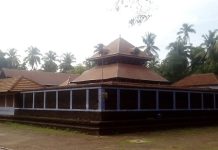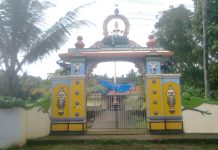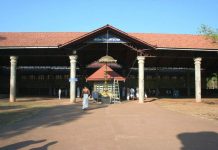The Agniswarar Temple, located in the village of Kanjanur, is a Hindu temple situated 18 kilometers northeast of Kumbakonam. The temple is dedicated to Lord Sukra (Venus), but the primary deity in the temple is Lord Shiva, worshipped as Agniswarar. According to Saivite beliefs, Lord Shiva is omnipresent, and Sukra is believed to be located within the stomach of the idol of Shiva.
The Agniswarar Temple in Kanjanur is one of the nine Navagraha temples in Tamil Nadu and is associated with Lord Sukran, making it an essential pilgrimage site for devotees seeking the blessings of this planet. Also known as Sukran Navagraha Sthalam, the temple is located around 18 km from Kumbakonam and 2 km to the east from Sooriyanayanar Kovil, on the Kallanai – Poompuhar road.
The temple’s main deities are Lord Shiva and Parvati, worshipped as Agneeswarar and Karpagavalli Amman, respectively. Unlike other Navagraha temples, there is no separate shrine for the Navagraha Sukra. The lingam of Agneeswarar, which represents Lord Sukra, is a special feature of the temple as it absorbs all the oil poured on it during the process of Abhishekam.
Kanjanur, also known as Palaasavanam, Bhrammapuri, and Agnistalam, is considered the 36th among the Tevara Stalams located in Chola Nadu north of the river Kaveri. The Agniswarar Temple’s rich history and unique features make it an essential destination for those interested in exploring Tamil Nadu’s cultural heritage.
Legend of Agniswarar Temple
The Kanjanoor temple is believed to have been blessed by Lord Shiva, who appeared in the form of Sukra to cleanse himself of his dosha (affliction) and bless the sage Parasara Muni with the cosmic dance. The temple is one of many located on the northern banks of the River Kaveri.
There are several other legends associated with the Kanjanoor temple. One is the story of Haradatha Sivachariyar, a Vaishnava who became a devout follower of Lord Shiva. Despite opposition from his fellow villagers, he proved his devotion by sitting on a heated iron stool and proclaiming Lord Shiva as the supreme deity. It is said that Lord Shiva appeared before him in various guises, including as a brahmin who took him home during a storm and as a devotee who visited his house to partake of his food offerings. Haradatha Sivachariyar also showed the world the importance of the five letters “Sivayanamah” and was taught the “Shiva Gnanam” by Lord Dakshinamurthy.
Another legend tells of a wealthy Shiva devotee who would offer food to Lord Agneeswarar every day, only to find out that the lord had gone to Haradhathar’s place in the form of an aged brahmin. Upon learning of Haradhathar’s devotion, the devotee visited him and paid his respects. In another story, a devout farmer who offered vegetables to Lord Shiva was left with only one piece of “Suraikkai” and, thinking it was not worthy of offering, decided to plant it instead. Lord Shiva visited him in the guise of a devotee and asked for food, and the farmer, hearing the lord’s divine voice, cooked and offered the vegetable. Lord Shiva blessed him and the farmer became known as “Suraikkai Bakthar.”
History of Agniswarar Temple
The Agniswarar Temple, also known as Palaasavanam, Brahmapuri, Agnistalam, and Neelakudi, has a rich history. Stone inscriptions in the temple mention Chola kings like Vikraman, Rajakesari, Kulothungan, Veera Rajendran, and the Vijayanagara King Krishnaraya Maharayar. The temple has gone by various names over the centuries, including Palasavanam, Parasarapuram, Brahmapuri, Agnipuram, Kamsapuram, and Mukthi Kshethram. Today, it is under the administrative control of the Madurai Thirugnanasambantha Swamigal Aadheenam.
The temple was originally built by the Medieval Cholas and later restored by the Vijayanagara Empire’s kings. A notable feature of the temple is that the oil Abishekam performed on the main Siva lingam is fully absorbed by the idol.
Architecture of Agniswarar Temple
The temple has a 5-tier rajagopuram and is surrounded by two prakarams. The temple is considered to be a Padal Petra stalam and is revered for the verses of Appar. The temple houses a Nataraja Sabha or Mukti Mandapam where stone pictures of Natarajar and Sivakami are found. The temple is also known for its rare stone idol of Natarajar. There is a separate shrine for Sukran (Venus) and shrines to Maanakkanjaarar Nayanmaar and Kalikkaamar. The temple is also significant for its association with Haradatta Sivacharayar, who underwent great trials to prove his devotion to Shiva. The temple also has a unique image of Haradatta worshipping Dakshinamurthy. The sacred water bodies in the temple are called ‘Agni theertham’ and ‘Parasara theertham,’ and the sacred tree is called ‘Palasa Maram.’ One of the unique features of the temple is the presence of five Vilva leaves, which is considered auspicious.
Festivals of Agniswarar Temple
Kanjanur Temple celebrates a number of festivals throughout the year, some of which are:
- Aadi Pooram: This festival is dedicated to Goddess Andal, an incarnation of Goddess Lakshmi, and is celebrated for 10 days in all Lord Vishnu temples in Tamil Nadu. The last day, known as Aadi Pooram, features a grand marriage ceremony of Goddess Andal and Sri Ranganathaswamy.
- Maasi Maham and Maha Shivratri: These festivals are celebrated in the Tamil month of Masi (Feb-Mar) and honour Lord Shiva or Shankara. Mahashivratri is celebrated with special prayers, and the Shivalinga is washed every three hours that day with cow’s milk, curd, honey, cow ghee, and water.
- Haradhathar Festival: This festival is celebrated in the Tamil month of Thai (Jan-Feb) and is dedicated to Lord Shiva.
- Navaratri: This festival is celebrated in the Tamil month of Purattasi (Sept-Oct) and honours the nine incarnations of the Goddess Shakti.
- Thiruvathirai: This festival is celebrated in the Tamil month of Markazhi (Dec-Jan) and celebrates the cosmic dance of Lord Shiva in the Nataraja form.
- Pradosham: This festival is observed regularly and is a special day of worship for Lord Shiva.
In addition, festivals for Anjaneyar (Lord Hanuman) are also celebrated at Kanjanur Temple.
Timings of Agniswarar Temple
The temple is open for visitors from 6:00 AM to 12:00 PM and from 4:00 PM to 9:00 PM.
How to reach the Agniswarar Temple
Air: The nearest airport to Kanjanur is the Thanjavur airport, which is 46 km away from the temple. The Tiruchirapalli (Trichy ) International Airport is also an option, which is located 105 km away.
Train: The nearest railway station to Kanjanur is the Mayiladuthurai railway station, which is 18 km away. Kumbakonam railway station is another option, located at a distance of 18 km.
Bus: There are direct local bus services available to Kanjanur from Mayavaram, Aduthurai, Thiruvidaimarudhur, and Kumbakonam. The temple is located on the Aduthurai-Kuthalam road, near the Kumbakonam highway in Thirunallar, and is around 17 km from Kumbakonam bus terminal.
























































